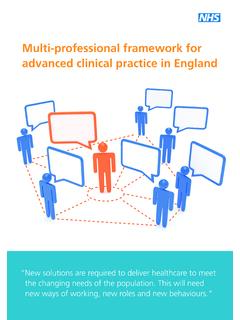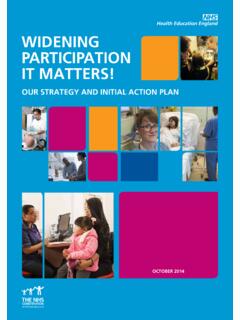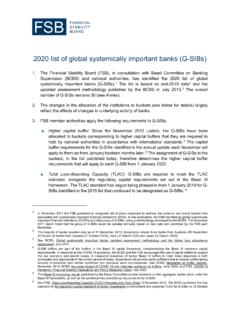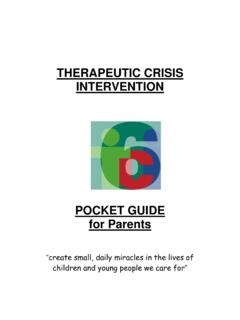Transcription of Growing Nursing Numbers Literature review on nurses ...
1 1 Developing people for health and healthcare Growing Nursing Numbers Literature review on nurses leaving the NHS A 2 Developing people for health and healthcare The following is based on a short review of the available Literature online around nurses (excluding midwives) who may be about to leave, have recently left or are registered but not practising - this cohort has euphemistically been called the leaky bucket . The Literature review included a broad review of research available online in the UK and internationally. In addition there was a specific focus on finding Literature on - Numbers of nurses in this category Background of nurses in this category Reasons why nurses leave Previous work done to retain and retrain nurses In summary there is likely to be around 10% of the Nursing workforce seriously considering leaving, and evidence shows that early signs of departure are strong predictors of the actual behaviour.
2 Turnover rates are likely to be higher in inner city hospitals and in specific branches of Nursing such as mental health, critical care, oncology and care for the elderly. Although some turnover can be positive, and bring in new ideas and innovation, high turnover can have a negative impact on patient care and create high costs for organisations and individuals, particularly if individuals leave due to burnout. Newly qualified nurses and nurses nearing retirement age are likely to leave. Job satisfaction, stress and burnout have also been found to have significant correlation with intention to leave and the UK has one of the highest rates of nurses reporting burnout across Europe. There are a number of risk factors associated with job dissatisfaction and stress which are outlined in the report.
3 stress and burnout are particularly high in young newly qualified nurses , where turnover rates tend to be high in the first year of qualification and remain high, or even rise during the second year of service before declining. Many of the factors that impact on nurses intention to leave are able to be modified to reduce the number of leavers. A nurse retention strategy that incorporates a number of options outlined in the report is likely to be successful in reducing turnover. Focusing efforts initially around newly qualified nurses and specific branches with high turnover should be the first step. This could also enable organisations to evaluate which strategies are the most effective. 3 Developing people for health and healthcare 1 Defining turnover The term turnover is used to refer to the totality of nurse leavers from an organisation this will include those moving within a sector (from one trust to another), those moving between sectors (from Nursing to non- Nursing ) and those leaving employment (due to ill health, retirement and so on).
4 Wastage refers only to those leavers who move outside of the organisation. 1 There are significant methodological challenges when attempting to measure and compare turnover. At the local level, the lack of consistency in how records of turnover are maintained presents difficulties, as the reliability of turnover determinations varies according to record keeping The different definitions of turnover used in studies also make it difficult to compare or generalise across studies. Voluntary and involuntary turnovers are not always differentiated in studies because costs are incurred regardless of whether staff resign or are requested to leave. Some studies define turnover as any job move while others consider nurse turnover as leaving the organisation or even leaving the Nursing As well as variations in definitions limiting comparisons, it should be noted that many of the studies on turnover have incomplete survey responses which may give an incomplete picture of turnover.
5 2 Turnover projections - around 10% of UK nurses intend to leave Many studies vary in their definition of intention to leave , and as a result studies vary significantly in their conclusion of the proportion of nurses intending to leave a review of international studies found between 4% and 54% intended to Central to the variation is the difference in the definition of intention to leave used and the nature of the questioning. For example, if nurses are asked simply would you leave Nursing if you could a high proportion say they would (38%),5 whereas studies that use less leading questions find the figure to be around 10%.6 As outlined in the table below, there is an increasing proportion of nurses leaving the Nursing and Midwifery Council (NMC) register: of nurses left the register between 2012 and 2013, only left due to retirement, and are known to have left voluntarily, while there is a lack of data around the remaining proportion.
6 The actual number of nurses leaving is also likely to be higher than as many leave while still registered and some will also move within the NHS, but to jobs away from direct clinical care. 1 Buchan J. (2002) Nursing and Midwifery Workforce Data a special report 2002/03. Chamberlain Dunn Associates. 2 Tai T W C, Bame S I, Robinson C D. (1998) review of Nursing turnover research, 1977 1996. Social Science and Medicine 47 (12), 1905 1924. 3 Hayes L J, et al. (2006) Nurse turnover: A Literature review International Journal of Nursing Studies 43 (2006) 237 263 4 Flinkman M, Leino-Kilpi H, Salantera S. nurses (2010) Intention to leave the profession: integrative review . Journal of Advanced Nursing . 2010;66(7):1422 1434 JAN5322 5 Scott H, (1996) Nurse shortages: why are nurses leaving the NHS?
7 British Journal of Nursing , Vol. 5, Iss. 18, 12 Oct 1996, pp 1098. Available at: ;article=BJN_5_18_1098;format=pdf (accessed 13 April 2014) 6 Heinen M M. et al (2012) nurses intention to leave their profession: A cross sectional observational study in 10 European countries Available at: (12)00330-6/fulltext#sec0070 (accessed 12th April 2014) 4 Developing people for health and healthcare It should also be noted that in England the headcount of nurses registered with the NMC was 583,285 in 2011, with just over half of these, 323,377, in the NHS in 2011,7 meaning 55% of registered nurses are not practicing in the NHS. Table 1:Proportion of nurses leaving the NMC register 2009/10 % of total qualified Nursing staff 2012/13 % of total qualified Nursing staff % change from 2009/10 to 2012/13 Total qualified Nursing staff working in the NHS 375,505 369,868 nurses who voluntarily left 4,293 5,422 26% increase nurses who retired 1,891 4,309 128% increase nurses leaving the register overall 21,949 23,952 increase Data sources: National Midwifery Council8 and Health and Social Care Information Centre for Workforce Intelligence (CFWI) suggested that there is a 5% difference of nurses leaving under the assumption that only moderate variation is likely in the economic However, it is unclear which nurses are in this cohort and how the proportion was arrived at.
8 A European study of Nursing in 10 countries provides a useful insight into the proportion of UK nurses that intend to leave the profession. The study had responses from 46 hospitals in the UK (covering 413 different units) and responses from 3,000 nurses , and the study found that 10% of UK nurses intended to leave the profession. The nurses mean age in the UK was years and 92% of all nurses were Evidence shows that early signs of departure are strong predictors of the actual A report on Nursing and midwifery workforce in 2001 found a similar proportion of nurses leaving the workforce - Nursing wastage (total leaving excluding transfers to other NHS units as a percentage of staff in post) was in England and A follow on report in 2002 found Nursing wastage was in England, with significant variation between regions the North West had only turnover 7 CFWI (2013) Future Nursing workforce projections starting the discussion Available at: @@publication-detail (accessed 12th April 2014) 8 Lintern S.
9 (25 Nov 2013) Thousands of nurses exit the profession Health Service Journal. 9 HSCIC (2014) NHS Hospital and Community Health Service (HCHS) Workforce Statistics in England, Summary of staff in the NHS - 2003-2013, Overview Available at: #top (accessed 13 April 2014) 10 CFWI (2013) Future Nursing workforce projections starting the discussion Available at: @@publication-detail (accessed 12th April 2014) 11 Heinen M M. et al (2012) nurses intention to leave their profession: A cross sectional observational study in 10 European countries Available at: (12)00330-6/fulltext#sec0070 (accessed 12th April 2014) 12 Murrells T, Robinson S, Griffiths P, (2008) Is satisfaction a direct predictor of Nursing turnover? Modelling the relationship between satisfaction, expressed intention and behaviour in a longitudinal cohort study.
10 Human Resources for Health 6, 22, 13 Buchan J (2001) Nursing and Midwifery Workforce Data 2000/01. A special report . Chamberlain Dunn Associates. 5 Developing people for health and healthcare compared to London with Table 2 outlines the main findings from the Table 2 Leavers in the year March 2001 Retirement % To other NHS units % To non-NHS units % Other % Don t know % Total leaving % Wastage rate % Registered staff Wales Scotland - - - England Northern and Yorkshire Trent Eastern South East London South West West Midlands North West Inner London Outer London London Fringe Rest of Great Britain Source.








![Midlands [1 of 2] - hee.nhs.uk](/cache/preview/6/c/1/4/2/e/2/7/thumb-6c142e2790d053a442bd8a3e81c79697.jpg)







